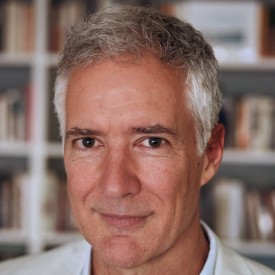Nick Mott is an environmental journalist who is a reporter and producer for Montana Public Radio, having launched podcasts such as Richest Hill. He has received accolades from the Associated Press and his work has appeared in NPR’s Morning Edition, Outside, The Washington Post, Alpinist, and more.
Justin Angle is a Professor of Marketing at The University of Montana, College of Business. There, he hosts the A New Angle podcast, which covers education, business, and culture through the lens of unique initiatives in Montana.
Below, co-authors Nick and Justin share 5 key insights from their new book, This Is Wildfire: How to Protect Yourself, Your Home, and Your Community in the Age of Heat. Listen to the audio version—read by Nick—in the Next Big Idea App.

1. Wildfire isn’t inherently bad. It just is.
In the summer of 2023, smoke from Canada choked the East Coast. There were mass evacuations in Yellowknife. Communities, like Lahaina in Hawaii, were destroyed. It was both a remarkable season and an utterly ordinary one.
The effects of wildfire are more present for more people than ever before. In 2020, wildfires scorched an area of the U.S. 50 times larger than New York City. Fire season is 80 days longer than it was 30 years ago. Every fire season, headlines sprout across the country: Fire threatens a community. A megafire burns 100,000 acres of forest. Smoke inundates cities. For those losing homes, livelihood, or lives, the impacts of wildfire are undeniably tragic. But there’s a much deeper story to tell.
While wildfires are burning more land than in living memory, we need to look historically at our relationship with fire. Ecosystems across the country depend on wildfire to thrive. In some forests, flames thin out dense undergrowth and make room for older, fire-resilient species to flourish. Some species can only reproduce after fire comes through. Animals like deer and elk, and even rare species like Canada lynx, depend on low-intensity, natural fires.
Wildfires have two competing roles in our world. We need to suppress and get rid of them, and yet we need more of them burning in the right places, in the right way. The thing is, this predicament is all thanks to us.
2. We got ourselves in this mess.
For millennia, wildfires shaped the landscape. Our forests and grasslands evolved with fire. Indigenous groups across the country used fire for hunting, foraging, and culture.
But when settlers colonized the West, fire became a problem. In 1910, a three-million-acre conflagration known as The Big Burn sent smoke across the country. The Forest Service—in its infancy—began an all-out war on flames. The so-called “10am rule” dictated that all burns were to be snuffed out by 10am the next morning. Educational and PR campaigns—like Smokey Bear—made wildfire public enemy number one. The country built a military-style apparatus dedicated to putting out fire. For decades, we were good at that. Forests that historically might have experienced natural wildfire every 10 to 30 years haven’t seen it in a century. That means they’re clogged up with fuel: small trees and shrubs, brush, all the stuff that would’ve been burnt out by those low-intensity burns. So, in many areas, when wildfire does come through, it burns faster and hotter than it would’ve naturally because the forest is so loaded up with that fuel. This is the first cause of our wildfire predicament.
“Across the West, about 16 million homes are in fire-prone areas.”
Second is how and where we’re developing. Thanks to the rising cost of living in city centers and the aesthetic appeal of residing among mountains and forests, more people are living in areas prone to wildfire than ever before. Those areas—called the wildland urban interface (WUI)—contain about a third of all homes in the U.S. Across the West, about 16 million homes are in fire-prone areas.
Third is climate change. Skyrocketing greenhouse gas emissions—caused, paradoxically by our addiction to burning fossil fuels—have created hotter, drier conditions. Less snow accumulates on top of mountains in the winter, and it melts off earlier than ever as what used to be spring snow falls as rain. Hotter, drier air further dries out trees and grass and other fuel, making it more flammable, and allows fires to burn bigger, faster, and during more hours of the day.
Combined, these factors have made wildfire feel like an unstoppable and deadly force.
3. We need more fire, not less.
Scholars say we’re in a fire deficit, meaning we ought to be experiencing a lot more wildfires based on our environmental conditions. This relates back to how we treat wildfires. Some firefighters like to say, “A fire put out is a fire put off.” Historic wildfires create barriers to newer ones. When a new wildfire erupts, it may hit a wall when it reaches a burned zone from, say, five to 10 years ago. But today, because we’ve been putting out so many fires, there are far fewer fire scars that can act as barriers on the landscape.
One solution is prescribed fire. That means a low-intensity wildfire, intentionally set in the right place at the right time which simulates how it might have burnt historically. These are hard to do: climate change is closing weather windows, prescribed burns gone awry generate political opposition, it takes staff and resources and environmental review, and people just don’t like smoke in the skies.
Fire professionals also like to say, “How do you like your smoke?” In big, suffocating doses—when big fires (like the Canadian ones this summer) erupt? Or in smaller, easier to tolerate pulses? The latter is what we can get with prescribed burns.
4. We can protect ourselves from flames.
Retired fire scientist Jack Cohen started studying how fires burnt homes back in the 1980s, before we were seeing the devastating fire seasons of today. He wondered: what causes homes to burn? He realized that it wasn’t the flames themselves that engulfed communities. Instead, embers drifted off the flames, sometimes miles away, and floated their way to rooftops and yards. This is what sets neighborhoods ablaze.
This seemingly basic realization set off a shift in his mindset: The problem isn’t wildfires. It’s with embers. We can’t control all wildfires, but we can control how vulnerable communities are.
“Embers drifted off the flames, sometimes miles away, and floated their way to rooftops and yards.”
There are some basic things we can do to make our neighborhoods more resilient. First, think about your roof. That’s like a giant landing zone for embers. If you have a wood roof, replace it with a fire-resistant material, like metal. Regularly blow out all the leaves and pine needles in your gutters. Seal up attic vents and soffits with fine mesh so embers can’t get in. If you have a wooden fence, replace the sections directly touching your house with fire-resistant material. Get rid of flammable woodchips and mulch and firewood next to your house.
Farther out from home, think about the things that can catch fire in your yard. That means trees and shrubs should have lots of space between them, and solutions might mean cutting some down to give vegetation the breathing room it needs. Think about creating breaks in fuel—like paths and walkways.
Lastly, think about what you and your family will do when a fire does come through. Are you signed up for your area’s emergency notices? Pack a go-bag with snacks, insurance documents, prescriptions, N95 masks, and other essentials. Talk with your family about where you’ll go during an evacuation, and how you’ll get there.
5. We need collective action, too.
The above are just some of the actions you can take to make your home more resilient. To find out more, connect with a local fire preparedness organization. In fact, in dense developments, your neighbor’s lack of fire resilience can spell danger for your home, too. Fire is a community issue, not just an individual one. Local organizations that can build trust among the community are crucial to addressing fire risk across the country.
If you don’t have one in your area, consider mobilizing your neighborhood, and talk about fire risk at community meetings. Other helpful solutions can mean creating community tool libraries so those without resources can get the work done too, or simply offering help to neighbors.
But change must come at the policy level as well. Some of the work required on homes costs a lot of money. Replacing all the wood roofs in fire-prone areas, for example, is estimated to be a $6 billion problem. Federal and local governments need to make a serious investment in community fire resilience, along with prescribed burning. We also need zoning and codes that make sure development is up to snuff when it comes to wildfire. Big picture policy change also means taking rapid and meaningful action on climate change.
Ultimately, we need to reformulate our relationship with wildfire, and recognize that the problem isn’t just out there, in forests. The problems are right where you live. That’s empowering. Each of us have the agency to create a more fire-resilient world.
To listen to the audio version read by co-author Nick Mott, download the Next Big Idea App today:
































